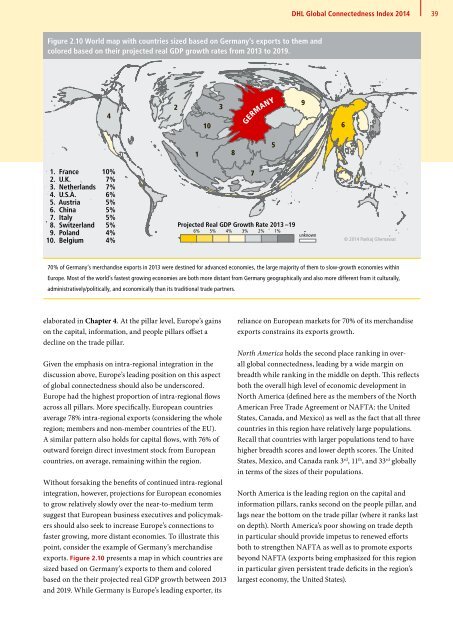DHL Global Connectedness Index 2014
DHL Global Connectedness Index 2014
DHL Global Connectedness Index 2014
- No tags were found...
You also want an ePaper? Increase the reach of your titles
YUMPU automatically turns print PDFs into web optimized ePapers that Google loves.
<strong>DHL</strong> <strong>Global</strong> <strong>Connectedness</strong> <strong>Index</strong> <strong>2014</strong><br />
39<br />
Figure 2.10 World map with countries sized based on Germany’s exports to them and<br />
colored based on their projected real GDP growth rates from 2013 to 2019.<br />
4<br />
2<br />
10<br />
3<br />
GERMANY<br />
9<br />
6<br />
1<br />
8<br />
5<br />
1. France 10%<br />
2. U.K. 7%<br />
7<br />
3. Netherlands 7%<br />
4. U.S.A. 6%<br />
5. Austria 5%<br />
6. China 5%<br />
7. Italy 5%<br />
8. Switzerland 5%<br />
Projected Real GDP Growth Rate 2013 –19<br />
6% 5% 4% 3% 2% 1%<br />
9. Poland 4%<br />
unknown<br />
10. Belgium 4% © <strong>2014</strong> Pankaj Ghemawat<br />
70% of Germany’s merchandise exports in 2013 were destined for advanced economies, the large majority of them to slow-growth economies within<br />
Europe. Most of the world’s fastest growing economies are both more distant from Germany geographically and also more different from it culturally,<br />
administratively/politically, and economically than its traditional trade partners.<br />
elaborated in Chapter 4. At the pillar level, Europe’s gains<br />
on the capital, information, and people pillars offset a<br />
decline on the trade pillar.<br />
Given the emphasis on intra-regional integration in the<br />
discussion above, Europe’s leading position on this aspect<br />
of global connectedness should also be underscored.<br />
Europe had the highest proportion of intra-regional flows<br />
across all pillars. More specifically, European countries<br />
average 78% intra-regional exports (considering the whole<br />
region; members and non-member countries of the EU).<br />
A similar pattern also holds for capital flows, with 76% of<br />
outward foreign direct investment stock from European<br />
countries, on average, remaining within the region.<br />
Without forsaking the benefits of continued intra-regional<br />
integration, however, projections for European economies<br />
to grow relatively slowly over the near-to-medium term<br />
suggest that European business executives and policymakers<br />
should also seek to increase Europe’s connections to<br />
faster growing, more distant economies. To illustrate this<br />
point, consider the example of Germany’s merchandise<br />
exports. Figure 2.10 presents a map in which countries are<br />
sized based on Germany’s exports to them and colored<br />
based on the their projected real GDP growth between 2013<br />
and 2019. While Germany is Europe’s leading exporter, its<br />
reliance on European markets for 70% of its merchandise<br />
exports constrains its exports growth.<br />
North America holds the second place ranking in overall<br />
global connectedness, leading by a wide margin on<br />
breadth while ranking in the middle on depth. This reflects<br />
both the overall high level of economic development in<br />
North America (defined here as the members of the North<br />
American Free Trade Agreement or NAFTA: the United<br />
States, Canada, and Mexico) as well as the fact that all three<br />
countries in this region have relatively large populations.<br />
Recall that countries with larger populations tend to have<br />
higher breadth scores and lower depth scores. The United<br />
States, Mexico, and Canada rank 3 rd , 11 th , and 33 rd globally<br />
in terms of the sizes of their populations.<br />
North America is the leading region on the capital and<br />
information pillars, ranks second on the people pillar, and<br />
lags near the bottom on the trade pillar (where it ranks last<br />
on depth). North America’s poor showing on trade depth<br />
in particular should provide impetus to renewed efforts<br />
both to strengthen NAFTA as well as to promote exports<br />
beyond NAFTA (exports being emphasized for this region<br />
in particular given persistent trade deficits in the region’s<br />
largest economy, the United States).





